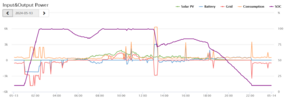My off peak is an EV tariff, there is also Economy 7 and Economy 10 and even a variable tariff depending on demand, we hear Octopus prices being quoted many times, each results in a different off peak charge. Plus it changes area to area and supplier to supplier a quick hunt for this address got

but for me to change I have an exit charge, and they fail to say what the solar rate is, and one in the main gets a higher payment for solar if you sell to same company you buy from. Also times vary even for same tariff, so for me in mid Wales to say what is the cheapest way to heat water, may not be valid in where
@Ch_152 lives.
However it does seem he/she is talking about changing his system to suit what is cheapest option, so there are three common systems:-
1) Twin element immersion fitted into top of cylinder.
2) Two independent elements fitted into side of cylinder.
3) Element outside cylinder (The Willis system).
Much depends on the cylinder in what can be fitted, and also the header tank, the old twin element system was designed for sink or bath and often had a switch marked as such, but often the thermostat did not have the safety cutout, basic not enough room, so can't use a thermal plastic header tank as these can split if hot water gets to them which can happen with faulty thermostat. Also the central heating hot coils can get in the way of fitting a long immersion heater from the top.
So the option 2) again depends on if you can get suitable adaptation for the cylinder, which is why the Willis became so popular in Ulster where it was invented, the system heats from the top down, so the longer it is switched on the more hot water you get, but unlike the other systems even when on for a short time you have hot water, it does not gradually increase temperature, but produces hot water which slowly fills more and more of the cylinder, seems a great system.
However when I looked for a plumber to fit it, I was met with a blank expression, this is the solar version
it works it seems very well with solar, but there is also a version without solar, but in mainland UK good luck finding some one who knows how to fit it.
So nitty gritty will one get a pay back from the money spent? The conversions will not be cheap, so 31.31 - 8.95 = 23.36 p per kWh saving if using off peak, my boiler needed to run every second day, so to maintain the DHW is going to require around 10 kWh in my house with minimum insulation on the tank which means it airs clothes, every two days, including the water I use. So for whole tank cost £2.60 per week, with is switching on 3 times at off peak times heating whole tank. If it only heats top of the tank, it will cost less, but likely it will not last the day so the cost will increase 23.36 p per kWh hard to do maths as don't know how much used, however due to increased cost of power, one is likely to have around the same bill, so the question is if it's all worth the effort?
As said I fitted iboost+ all with the idea of saving money, but in fact a simple time clock would have saved more. And an iboost+ is not cheap. Let
@Ch_152 do the maths for his house and say is it really worth the effort?




